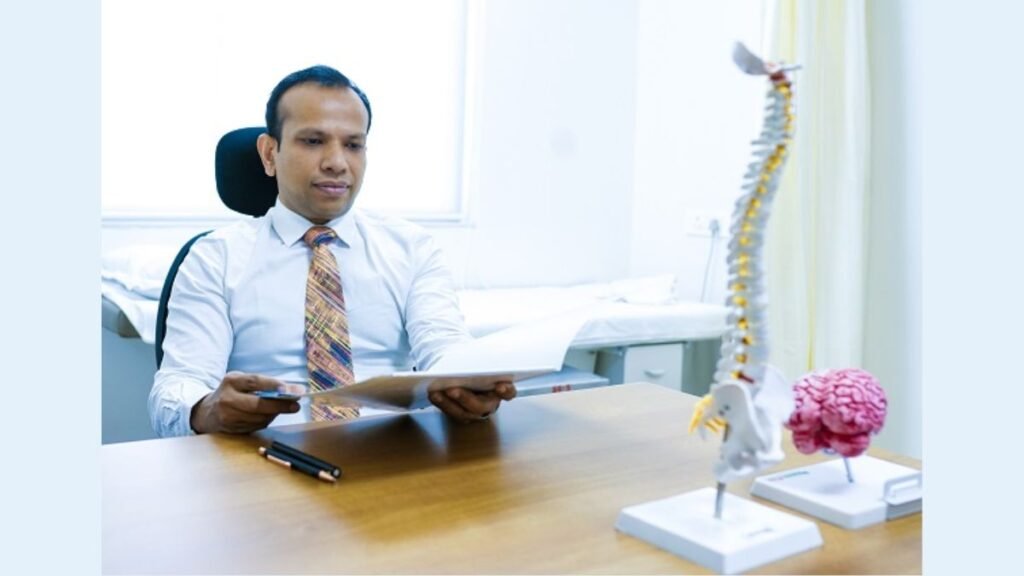
Dr. Vishal Bhasme, a Leading neurosurgeon Ruby Hall Clinic and Lopmudra Hospital, Pune
New Delhi (India), June 2: Back pain is a prevalent condition that affects a significant portion of the population. As a leading neurosurgeon in Pune at Ruby Hall Clinic and Lopmudra Hospital, Dr, Vishal Bhasme has extensive experience in diagnosing and treating patients with back pain. His expertise in spine surgery and treatment allows him to provide comprehensive care and effective solutions to patients seeking relief from back pain. He says most patients with neck and back pain do not need surgery; targeted therapy can improve their condition.
In this article, Dr. Bhasme aims to educate and assist our audience in understanding the causes, diagnosis, treatment options, and preventive measures for back pain.
Common Causes of Back Pain:
1.Sprains and strains: Overstretching or tearing ligaments and muscles in the back can result in pain and discomfort.
2.Disc prolapse: A common cause of low back pain, it occurs when one of the spinal discs bulges or ruptures, putting pressure on surrounding nerves.
3.Radiculopathy (sciatica): Compression, inflammation, or injury to a spinal nerve root can lead to pain, numbness, or tingling sensations in the legs or arms.
4.Spondylolisthesis: This condition involves the slippage of one vertebra over another, causing back pain and potential nerve compression.
5.Spinal injuries: Trauma or accidents can cause various types of spinal injuries, resulting in back pain and potentially affecting nerve function.
6.Spinal stenosis: Narrowing of the spinal column that puts pressure on the spinal cord and nerves, leading to pain, numbness, and weakness in the legs over time.
7.Infections, tumors, arthritis, and osteoporosis can also contribute to back pain.
When to Seek Medical Attention:
Consult a Neuro Spine Specialist if you experience:
1.Severe neck or back pain that does not improve with rest.
2.Numbness or tingling in your arms and legs.
3.Pain after a fall or injury.
4.Pain radiating to your arms or legs.
5.Trouble urinating.
6.Weakness or numbness in your hands or legs.
7.Fever accompanying back pain.
Diagnosis of back pain:
To diagnose the cause of back pain, a complete medical history, thorough back examination, and neurologic tests may be conducted. The following imaging and diagnostic methods might be used:
1.X-ray: Provides a basic view of the spine and can help identify fractures or other structural abnormalities.
2.Computerized tomography (CT): Offers detailed cross-sectional images, useful for detecting spinal stenosis or fractures.
3.Myelograms: Involves injecting a contrast dye into the spinal canal before taking X-rays or CT scans, enhancing the visibility of the spinal cord and nerve roots.
Treatments for back pain:
Non-Surgical Treatment:
●Physical Therapy: Customized exercise programs and therapeutic techniques to strengthen muscles, improve flexibility, and correct posture.
●Medication: Prescribing pain relievers, muscle relaxants, or anti-inflammatory drugs based on the severity and cause of the pain.
●Chiropractic Care: Adjustments and spinal manipulation to address misalignment and restricted joint movement.
Minimally Invasive Procedures:
●Epidural Steroid Injections: Administering anti-inflammatory medication directly to the affected area to reduce inflammation and alleviate pain.
●Facet Joint Injections: Targeted injections of anaesthetics and anti-inflammatory medications to relieve facet joint-related pain.
Surgical Intervention:
●Discectomy: Removal of a herniated disc to relieve nerve compression and pain.
●Spinal Fusion: Joining vertebrae together to stabilize the spine in cases of severe instability or degenerative conditions.
●Laminectomy: Removing a portion of the vertebra to alleviate nerve compression and create space for the nerves.
Rehabilitation and Pain Management:
●Physical Therapy: Post-operative or non-surgical rehabilitation programs involving exercises, stretching, and strengthening.
●Pain Management: Collaborating with pain management specialists to develop personalized plans for controlling pain and improving quality of life.
Tips for back pain relief:
1.Exercise moderately: Engage in activities like walking, swimming, or cycling for 30 minutes daily to strengthen and increase flexibility in your back muscles.
2.Practice yoga: Regular yoga sessions can stretch and strengthen your muscles, improve posture, and promote a healthier back.
3.Maintain proper posture: Avoid slouching, sit in a chair with good back support, and ensure the correct position and height for the task at hand.
4.Sleep posture: Sleep on your side with your knees drawn up to relieve pressure on your back. Use a firm mattress for better spinal alignment.
5.Lift correctly: Avoid lifting objects that are too heavy; use proper lifting techniques, and lift with your legs instead of straining your back.
Dr. Vishal Bhasme takes a patient-centred approach to back pain treatment. By combining his expertise in spine treatments, he strives to help his patients achieve long-term relief and improved functionality in managing their back pain.
If you have any objection to this press release content, kindly contact pr.error.rectification[at]gmail.com to notify us. We will respond and rectify the situation in the next 24 hours.

